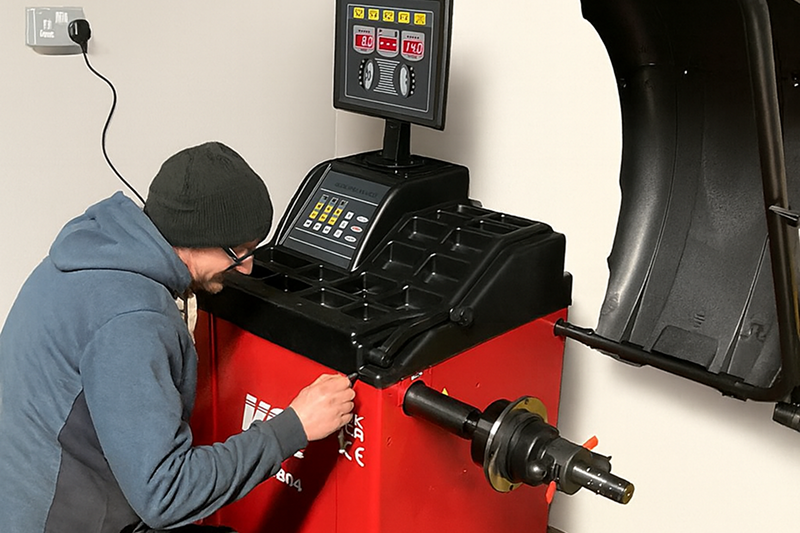We use cookies to make your experience better. To comply with the new e-Privacy directive, we need to ask for your consent to set the cookies. Read our Privacy and Cookie Policy.

Consistent wheel balancing is one of the fastest ways to reduce customer comebacks, improve ride quality and protect profit in a busy tyre bay. This guide sets out a practical, step-by-step workflow your team can follow on every job.
Why wheel balancing matters
- Prevents vibration through the steering wheel, seat and floorpan.
- Reduces uneven tyre wear and protects suspension components.
- Improves customer satisfaction and cuts free rework.
- Supports higher bay throughput with fewer repeat visits.
If you need an overview of equipment options, see our category page for a wheel balancing machine that suits your workflow and volume.
Common symptoms of imbalance
- Speed-dependent vibration that peaks at specific road speeds.
- Feathered or cupped tread wear patterns.
- Customer complaints after recent tyre replacement.
- Steering wheel shimmy despite correct alignment.
Root causes you can control
- Poor centring on the shaft — wrong cone/collet or front-coning on wheels that require back-coning.
- Contamination — dirt, rust or adhesive residue on hub faces and rims causing false readings.
- Incorrect weight placement — weights off the recommended planes or not seated fully.
- Out-of-date calibration — machine drift leading to technicians “chasing weights”.
- Tyre seating issues — bead not fully seated, causing radial force variation and ride disturbance.
The repeatable balancing workflow
- Intake check — note speed of vibration, recent work, wheel size and TPMS status.
- Prep and clean — remove old tape weight adhesive, clean rim, inspect for damage.
- Choose the right adapters — use back-coning and flange plates/collets to ensure true centring.
- Measure — spin and record both static and dynamic planes.
- Place weights accurately — follow machine guidance for clip-on or adhesive weights; re-spin to confirm.
- Road test or simulated check — verify the vibration is eliminated at the reported speed.
- Document — note weight amounts/positions and any wheel or tyre defects for customer transparency.
Equipment & calibration tips
- Run a daily zero check and schedule routine calibration to avoid drift.
- Standardise adapters and protect them from wear; replace damaged cones and collets.
- Use laser/positioning aids where available to speed accurate weight placement.
- Train every technician on centring repeatability checks to cut rework.
Upgrading to a modern tyre balancer with clear placement guidance and quick calibration routines can significantly reduce “chasing weights”.
When to recommend balancing to customers
- After fitting new or rotated tyres.
- When customers report speed-specific vibration.
- After suspension or steering repairs.
- When you see uneven or cupped wear patterns.
For busy shops, a reliable wheel balancer helps turn these opportunities into first-time-right outcomes.
Throughput and ROI
Reducing comebacks by even a small percentage frees bay time for paid work. Combine standardised workflow, good tooling, and a capable wheel balancer machine for sale to raise effective hourly recovery and customer ratings.
Quick troubleshooting table
- Vibration still present after balance — re-verify centring; perform repeatability check; inspect tyre for runout.
- Weights keep moving — decontaminate rim, use correct adhesive and press-on technique, choose clip-ons where suitable.
- Machine gives inconsistent results — recalibrate, inspect shaft and adapters, replace worn components.
When persistent issues occur, escalate to diagnostics or consider a higher-spec tyre balance machine with advanced measurement and placement guidance.
Wheel Balancing FAQs
Is wheel balancing the same as wheel alignment?
No. Balancing corrects the weight distribution of the wheel and tyre assembly to remove vibration. Alignment adjusts suspension angles (camber, caster, toe) so tyres track straight and wear evenly.
How often should wheels be balanced?
Balance after fitting new tyres, when rotating tyres, and any time the driver reports vibration or sees uneven wear. Many workshops add balancing to routine maintenance intervals.
What symptoms point to an imbalance?
Speed-dependent vibration in the steering wheel, seat or floor; cupping/scalloping on the tread; increased road noise; or a comeback soon after tyre replacement.
Do EVs and large alloy wheels need special consideration?
Yes. EVs are heavier and more sensitive to imbalance, while large, wide alloys demand precise centring and weight placement. A modern tyre balancer with good adapters and placement guidance helps achieve first-time-right results.
What’s the difference between dynamic and road-force balancing?
Dynamic balancing corrects imbalance across two planes by adding weights. Road-force balancing also measures tyre/wheel uniformity under load to diagnose stubborn vibrations that persist after a standard balance.
Clip-on or stick-on weights — which should I use?
Use the type recommended for the wheel design and finish. Follow your balancer’s placement planes and re-spin to confirm. Proper surface prep prevents weight movement.
What tools help reduce comebacks?
Accurate centring adapters/collets, flange plates for tricky wheels, routine calibration, and a capable wheel balancer with laser/position aids. Upgrading to a high-spec wheel balancer machine for sale can speed setup and improve repeatability.
When should I recommend a balance to customers?
After new tyres, rotations, suspension work or whenever vibration is reported. For equipment options, see our wheel balancing machine range.
Next step: Browse our range to choose the right wheel balancing machine for your bay. If you’re scaling capacity, consider adding a second tyre balancer to remove throughput bottlenecks.



